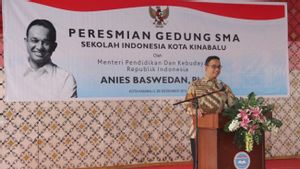JAKARTA - Centuries ago, spices, especially pepper, were the most sought after commodities in the world. Pepper is expensive: it can buy positions, livestock, houses, to women. Therefore, pepper became a bone of contention for Europeans. They are willing to risk their lives just to find pepper. The adventure was a success. The archipelago emerged as a world pepper producer. Pepper has also become a mainstay commodity for the Kingdom of Aceh and the Sultanate of Banten. The production is abundant, so are the profits.
Long ago, Europeans were used to consuming minimally spiced food. They think that a good meal only has smoked meat sprinkled with salt. However, that perception changed when spices, especially pepper appeared in Europe.
Pepper like the most sought after heavenly plant. The fruit of a Latin plant called Piper Nigrum is transformed into a universal flavoring for all foods. From then on, all kinds of European recipes began to place pepper as the most important kitchen spice. This fact is evidenced by the many archaeological findings related to the existence of pepper in mainland Europe. The discovery of silver pepper pots (peperatoria), for example.
It is like a key witness that pepper was once widespread in every European culinary joint. This view is corroborated by the presence of one of the world's oldest period books written by Apicius between the 4th and early 5th centuries, De Re Coquineria. In it, strictly speaking the use of pepper in cooking recipes is commonplace for all Europeans.
“Based on the work of Apicius, it seems that the Romans liked spicy food. There are about as many references to spices in De Re Coquineria as, say, olive oil references in modern Italian cookbooks. Pepper itself appears in 349 of the 468 resp in this book (De Re Coquineria). Spices are used for flavoring to flavor vegetables, fish, meat, wine, and desserts.”
“The very first recipe is a spiced wine surprise. Then followed the honey-spiced wine for the traveler. There are salted spices for various purposes, including a mixture to aid digestion and move the colon, and for the second function mentioned, the mixture consists of white pepper, black pepper, thyme, ginger, menthe, cumin, celery seeds, parsley. , oregano arugula, kuma-kuma, bay leaf, and dill,” says Jack Turner in the book History of Spices: From Eroticism to Imperialism (2019).
Furthermore, the appeal of pepper is not only considered a mere food flavoring. But pepper has also become an important part of life throughout the country. All because the presence of pepper often creates a desire or obsession to master pepper. Pepper's power can buy anything. Because, pepper has a high value. Moreover, it becomes a bone of contention for many people.

Whoever wants to get pepper, then they have to travel far across the ocean to stop in mainland Asia. From pepper producers in China to the archipelago. After all, the costs incurred are not small. Even the risk is quite large: death.
“Pepper is the ideal medium of exchange. It is as valuable as it is made of gold. Passage fees, rent, taxes, even court fines, can be paid with pepper. Lada can buy land and islands, pay off mortgages, and buy citizenship and full weapons.”
“The most beautiful women, the bravest horses, the most beautiful jewels, precious carpets, rare animal hairs: everything can be had with pepper,” said Paul Herrmann as written by P. Swantoro in the book Pepper Trade XVII: The struggle for White and Black Gold in the Archipelago (2019).
The Kingdom of Aceh and the Sultanate of BantenThe existence of Aceh as a world pepper port is not an empty message. Aceh's pepper trade has achieved success that no other country or kingdom can match. Aceh was the main supplier of about half of Europe's pepper needs in the 1550s.
The success of the pepper trade then inspired the Aceh Sultanate to control the west to east coast of Sumatra. The peak of Aceh's glory in producing pepper came during the reign of Sultan Iskandar Muda. The charismatic king managed to monopolize the pepper trade in Sumatra. The king lightly played the price of pepper which Europeans could not help but buy.
Sultan Iskandar Muda needed four porters. They were tasked with regulating and supervising the pepper trade in the Aceh port. In fact, the position of harbormaster in other ports in the archipelago is usually filled by only one or two officials.
"The crowds at the Port of Banda Aceh Darussalam at the time of Sultan Iskandar Muda needed several porters. If I'm not mistaken the number is four too, at least three people. During the visit of the French General Beaulieu, it is said that a porter with several officers and a clerk of the customs office came in a small canoe after the French ship had anchored."
“They brought the tokens sent by the Sultan, handed over a list of valuables to be presented to the palace, then returned to land. the next day the visit to the Palace was carried out with a parade. Each gift to the sultan was covered with a fine yellow cloth. If there is an official letter that must be submitted, then this letter is carried on a silver offering tray covered with handles embroidered with gold thread,” explained Maritime Historian Adrian B. Lapian in the book Shipping and Perniagaan Nusantara 16th and 17th Century (2017). ).

The pepper trade in the Sultanate of Banten was no less crowded. Banten's role as one of the drivers of the world's spice trade route with pepper commodity is not usually taken for granted. Banten is the second largest pepper exporter in the archipelago after Aceh. Traders from Asia to Europe came to look for pepper.
China became the main consumer of Indonesian pepper in the next century: the 15th and 16th centuries. The amount of pepper exports to China reached around 50 thousand zak. While the results of the archipelago pepper are approximately 60 thousand zak every year.
That amount makes the pepper consumed by China no less than the Europeans. Chinese traders generally get pepper from Javanese traders who exist from the port in Banten. After that pepper became a bone of contention. People from all nationalities came to Banten to get pepper.
“Banten is clearly known as one of the big ports in the archipelago. Attracted by pepper, traders from all over the coast of the Indian Ocean and the China Sea came to Banten to trade their wares. We still remember the impressive list of nations found in this city in 1596.”
“The Dutch were amazed and delighted when they made their first voyage to Southeast Asia: Persians, Gujarats, Malabars, Kelings, Pegu, Malays, Chinese, Turks, Arabs and Abyssinians, countless Portuguese have trade in this area since almost 80 years. In the already long list, it is necessary to add to the second half of the 17th century the British, Danes, French and of course the Dutch,” concluded Claude Guillot in the book Banten: History and Civilization of the X – XVII Century (2008).
*Read other information about HISTORY or read other interesting articles from Detha Arya Tifada.
Other MEMORIESThe English, Chinese, Japanese, Arabic, and French versions are automatically generated by the AI. So there may still be inaccuracies in translating, please always see Indonesian as our main language. (system supported by DigitalSiber.id)









